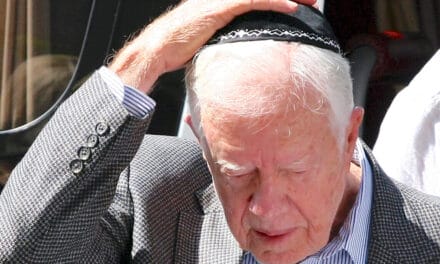By GIL TROY
(August 2022 / Jewish Journal JNS)
It’s become an annual modern ritual. Every summer, before Tisha B’Av, the ninth of the Hebrew month of Av, many serious Jews wonder whether to still fast on this day commemorating the First and Second Temples’ destruction—along with many other persecutions Jews endured on that day over the millennia. Especially in a united Jerusalem, with Israel noting its 75th anniversary, it seems anachronistic to recreate our grandparents’ despair yet again.
Tisha B’Av, this year, 2023, starts the evening of July 26 and continues on July 27.

Portrait of Berl Katznelson. Photo courtesy of Kluger Zoltan via Wikimedia Commons.
One Jerusalemite friend fasts, keens, prays—but ends the fast four hours before sundown, toasting modern Israel with biblical readings emphasizing that when redemption comes, the mourning will end. This religious dispute goes far beyond how rigorously one adheres to Jewish law. This debate, about how to remember history, and what to forget, gets to the heart of the Zionist revolution—and some democratic dilemmas today too.
Rejection Of Tradition
In 1934, Berl Katznelson, an avowedly secular Socialist Zionist living in Tel Aviv, criticized members of his youth movement for going off to camp on Tisha B’Av. In embracing Zionism as the Jewish people’s national liberation movement, these young revolutionaries happily rejected their perceived suffocating, depressing, religious upbringing. They ate on Yom Kippur. They had bread on Passover. And, instead of wailing on Tisha B’Av, they celebrated the Jews’ return to Zion—even before Israel’s establishment. Each assault on tradition affirmed their status as New Jews, not those pathetic, passive, pious, persecuted Yids they fled in “Galut,” exile.
Katznelson himself enjoyed impeccable revolutionary credentials. Born in 1887 in a village called Babryusk, located in today’s Belarus, he plunged into turn-of-the-century Russia’s rousing Marxist debates. His universalist crusade for equality, however, never weakened his ties to the Jewish people or his Zionist dreams. Arriving in Palestine in 1909, he joined the trickle of “Second Aliyah” ideologues building the land—and being rebuilt by it, too.
This sincere socialist first worked as a farmhand. Eventually, his skills as labor organizer, speaker, writer, editor and co-founder in 1925 of the workers’ daily newspaper, Davar, made Katznelson the bard of Socialist Zionism. His fatal aneurysm in 1944 at age 57 deprived Labor Zionists of a defining figure. Today, it leaves him more forgotten than friends who established Israel four years later, including David Ben-Guron.
Enduring Cultural Value
Katznelson was fuming that summer of 1934. True, he was not the first revolutionary to find younger revolutionaries too revolutionary, but he had a point. In a Davar column entitled “Destruction and Detachment,” Katznelson attacked these Tisha B’Av revelers for failing to “wail about our destruction, our enslavement, our embittered exile.” What’s the value of a national liberation movement, he wondered, if it isn’t rooted in its people’s rhythms, and only remembers how to forget?
For Socialist Zionists, he insisted, the Ninth of Av has the same significance as it has for every Jew. We all lost our land, our freedom, our hope when the Romans destroyed the Second Temple in 70 CE, triggering the 1,900-year-exile Zionists sought to end.
Ultimately, Katznelson forgave these young amnesiacs. But, he warned, there is no salvation in our movement of national salvation for those with “no instincts for the national spirit, for historic symbols, for enduring cultural values.”
Forgetting Of History
Katznelson soon decided to confront the intellectual rot underlying this canceling of history. The result was what may be his most memorable essay, “Revolution and Tradition.”
First establishing his revolutionary credentials, Katznelson catalogued the many rebellions flowing from their Socialist Zionist revolt against Jewish homelessness and powerlessness. We’re rejecting “the worship of diplomas among our intelligentsia,” the older Jewish socialist intelligentsia’s “assimilationist utopia” and bourgeois Europeans’ “rootlessness and middleman ship,” he rejoiced. But good revolutionaries don’t just smash toys like children having a temper-tantrum. Recoiling from Nietzsche’s nihilism, already fearing Hitler’s Nazism, Katznelson warned that erasing the past often yields a barbaric present. Even revolutionaries need balance.
Juggling, Katznelson taught that people are “endowed with two faculties—memory and forgetfulness. We cannot live without both. Were only memory to exist, then we would be crushed under its burden. We would become slaves to our memories, to our ancestors. Our physiognomy would then be a mere copy of preceding generations. And were we ruled entirely by forgetfulness, what place would there be for culture, science, self-consciousness, spiritual life?”
Katznelson’s “revolutionary constructivism” rejects the rigidity of “arch conservatism” and the anarchism of primitive “pseudorevolutionism.” Instead, he said, we sift.
“A renewing and creative generation does not throw the cultural heritage of ages into the dustbin,” he preached. “It examines and scrutinizes, accepts and rejects. At times it may keep and add to an accepted tradition. At times it descends into ruined grottoes to excavate and remove the dust from that which had lain in forgetfulness, to resuscitate old traditions, which have the power to stimulate the spirit of the generation of renewal. If a people possesses something old and profound, which can educate man and train him for his future tasks, is it truly revolutionary to despise it and become estranged from it?”
Initially, Katznelson speaks Marxist, sounding very theoretical. He ends by sounding downright rabbinic, sermonizing, using the Jewish calendar to uncover his people’s true character. “The Jewish year,” he reasoned, “is studded with days which, in depth of meaning, are unparalleled among other peoples. Is it advantageous—is it a goal—for the Jewish labor movement to waste the potential value stored within them?” Instead, he suggested, we “must determine the value of the present and of the past with our own eyes and examine them from the viewpoint of our vital needs, from the viewpoint of progress toward our own future.”
First, delighting in his peers’ Zionist journey from bondage to freedom, he analyzed Passover. Celebrating the storytelling m’dor l’dor, from generation to generation, Katznelson crafted two sublime sentences that should be required reading at every seder. “I know no literary creation which can evoke a greater hatred of slavery and love of freedom than the story of the bondage and the exodus from Egypt,” he wrote. “I know of no other remembrance of the past that is so entirely a symbol of our present and future as the ‘memory of the exodus from Egypt.’”
The Power Of Observance
Returning to his summer-time obsession, Tisha B’Av, Katznelson noted how Polish and Russian exiles in Paris and elsewhere assimilated quickly, forgetting their identities. By contrast, “the Jewish nation … remains unvanquished by two thousand years of dispersion.” That is because “Israel knew how to preserve the day of its mourning, rescuing the date of its loss of freedom from oblivion … On each anniversary burning tears were shed and each generation expressed its pain.”
Remarkably, the non-Jewish Polish national poet, Adam Mickiewicz, attended synagogue every Tisha B’Av to “join the Jews in their mourning over the loss of their motherland.” As a thwarted nationalist, Mickiewicz appreciated this exercise in memory-making and national conscious raising. He “understood the power and depth of Tisha B’Av.”
Finally, refuting those who wanted to celebrate the revitalized homeland on Tisha B’Av, Katznelson warned that too many Jews remained endangered, from the physical threats in Europe and Arab lands, to the spiritual threats through assimilation in “capitalistic France” and elsewhere. Taking a leap of hope, Katznelson left open the possibility of dramatic change once the Jews experience a “complete liberation from bondage—including its liberation from the oppression of class by class.” But, even if salvation were to come, he hoped “that each child born in liberty and equality, unacquainted with hunger and material oppression, shall know the sufferings of all preceding generations.”
“Revolution and Tradition” explains why Jews should commemorate Tisha B’Av, even in freedom. Reading Katznelson today underscores the Zionist revolution’s many miracles: 88 years later, most Jews wake up every day free and comfortable, especially after millions found refuge, and dignity, in Israel, which now houses the world’s largest Jewish community. More broadly, Katznelson appreciates history and memory as essential glues uniting communities, bucking up the people. He therefore warns against conservatives too stuck in the past as well as progressives who trash the past. Today, we see how such blinders create conservatives who fail to conserve institutions, and progressives who don’t believe in progress.
Katznelson’s middle path is constructive. Destructive either-or fanaticism offers one-way tickets to barbarism. Liberal democracies require sifting, remembering and forgetting, looking backward and forward, embracing just enough from the past to be rooted and wise, while dreaming just enough about the future to be ambitious and creative.
Prof. Gil Troy is the author of The Zionist Ideas and the editor of the three-volume set, Theodor Herzl: Zionist Writings, the inaugural publication of The Library of the Jewish People. This article was first published by The Jewish Journal.








